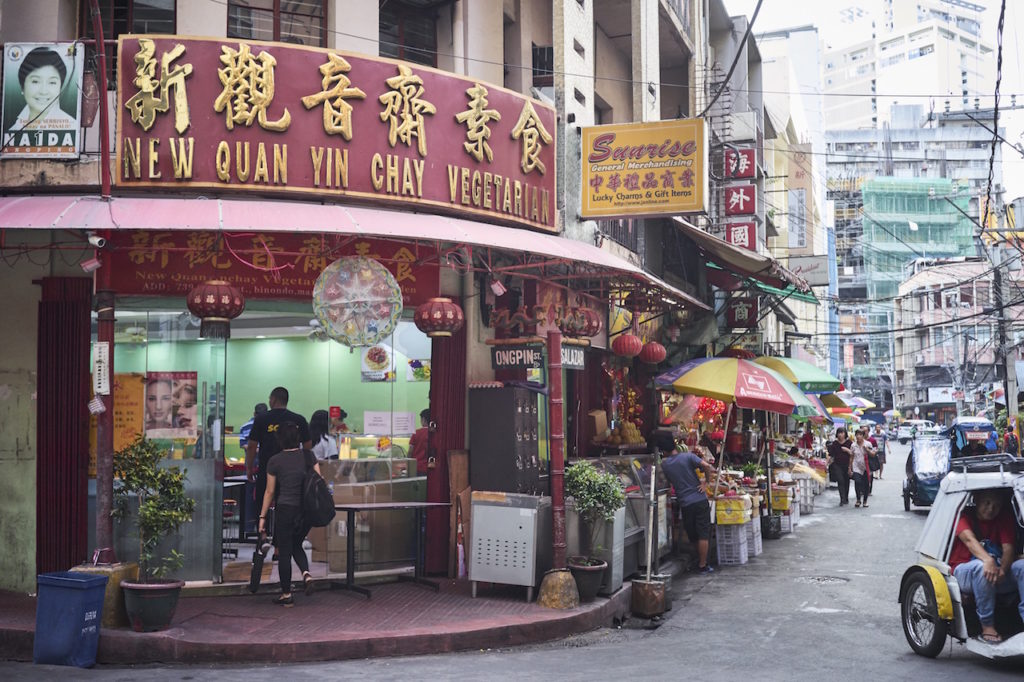Binondo is an old riverside commercial district in Manila that has long been associated with the city’s Chinese quarter. For over 400 years, its existence has been parallel to the economic development of the city. Today, the neighborhood has retained its established commercial character, but it has also evolved into a cultural-culinary destination within the National Capital Region.
In the books
This is not an entirely new phenomenon. Historically, Binondo has been the de facto dining-out place for Manileños since the 1800s, referenced through Jose Rizal’s two seminal novels. In “Noli Me Tangere” (1887), the opening chapter starts with a party by a capitan named Tiago at a house located along Anloague Street, known presently as Juan Luna Street. In “El Filibusterismo” (1891), Rizal writes of a student party hosted at the Panciteria Macanista de Buen Gusto along San Fernando Street.
Period photos reveal that such a place existed and to this day, the three-story bahay na bato still stands but in a dilapidated state. In more recent times, baby boomers wax nostalgic about the good old days in the ’50s and ’60s when their parents took them to Sunday lunches among Chinatown’s selection of panciterias: Moderna, Nacional, See Kee, Carvajal, Smart, Ramon Lee, Mañosa. For a noodle fix, people went to Ma Kong (or Ma Mon Luk) or Ling Nam Noodle House.


Most of these names are all but lost to today’s generation. Even so, Binondo has always thrived—and survived—in the fickle Manila food scene. For one, Binondo’s reputation as a culinary destination is still solidly etched among most of the locals’ subconscious. And this is not without basis: Think over 250 food-related establishments crammed within 0.66 square kilometers. They range from groceries and hole-in-the-walls to fast food, family style, and lauriat fine dining. This being Chinatown, a good percentage of these establishments reflect the taste of the ethnic Chinese community and are largely dominated by Cantonese and Hokkien-style offerings.
Still, it’s not all typical Southern Chinese fare in Binondo. One of the most popular restaurants that took off served northern Chinese-style fare, which included chive-infused dumplings. The last remaining bastions of old Chinatown dining, the panciterias such as Toho (est. 1888) along Tomas Pinpin Street together with the classic Ongpin Street greasy-spoon joint Estero, still attract regular patrons with their versions of a Tagalized Chinese-inspired cuisine.
Binondo boom
Within Binondo itself, eating is as much a daily ritual as it is a social pastime. And it’s just as well that this high-density neighborhood has the establishments to cater to this lifestyle. This is a place where there is always another reason to eat. For the immigrant or local Chinese residents, it could be a multi-course lauriat at a family clan association party. For the sports fan or churchgoer, it’s impromptu shabu-shabu or dim sum nights after a basketball game or a rehearsal. For the casual weekend tourist, it’s sampling one of the traditional family-run neighborhood joints you won’t find in a gated community.
However, Binondo’s reputation as a Tsinoy cultural-culinary hotspot was truly institutionalized with the introduction of food tours. In 2005, specialist tour outfit Old Manila Walks began offering a series of historically-themed walks around inner-city districts. It included one in Chinatown wittingly titled “The Big Binondo Food Wok!”
Almost overnight, Binondo’s once community-centered food scene was suddenly thrust open to the public, who descended on Binondo with fresh eyes and an appetite for adventure. In time, with continuous promotion on all fronts, Chinatown has evolved into an urban culinary destination within the metro that attracts a fair share of local visitors. And despite newer and more accessible Chinese food streets in Banawe in Quezon City and Wilson in San Juan, Binondo still holds a certain mystique to many because the food is connected with the history and culture of the community.
Most come to partake in a food trip. It could be for that freshly rolled Amoy-style lumpia housed in a 1930s Art Deco building or that steaming bowl of traditional bamboo-kneaded mami inside that joint with a decidedly 1960s interior.
In Binondo, the culinary experience is as much about the food as it is about the place’s character. But the reality is that going to this hub to eat is not for the fussy foodie nor is it everyone’s cup of tea. There’s the perceived physical challenge—tight streets, inner-city traffic jams, and broken pavement. And as storied as some of the establishments are, not all are up to par with modern quality and sanitation standards.
But despite these challenges, Chinatown’s reputation remains solid and intact. It’s a place of diametric contradictions among the Tsinoy community—a spot in old Manila that provides a comforting taste of the food that nourished their ancestors. And for new immigrants, it is a testing ground for introducing traditional recipes from the old country to this new city they now call home.
At the end of the day, it is this inherent combination of heritage, tradition, mercantilism, and innovation, all of which define the community way of eating, that makes Chinatown a culinary powerhouse within Manila. And whatever your opinion may be, food will never be far from the true Binondo experience.
Originally published in F&B Report Vol. 15 No. 3

